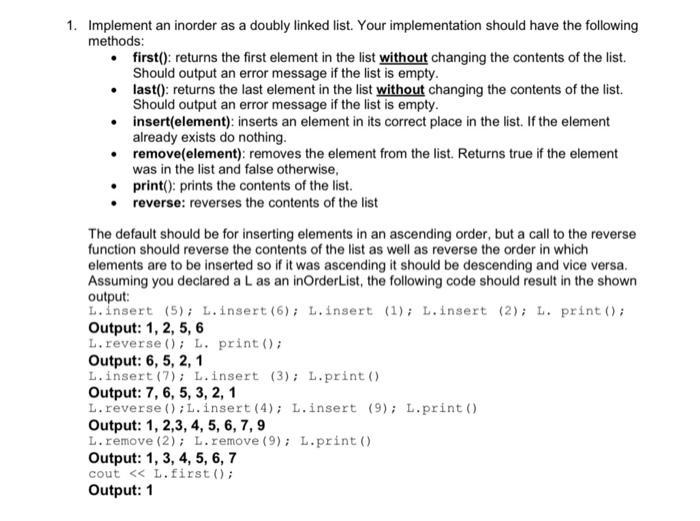Answered step by step
Verified Expert Solution
Question
1 Approved Answer
1. Implement an inorder as a doubly linked list. Your implementation should have the following methods: first(): returns the first element in the list

1. Implement an inorder as a doubly linked list. Your implementation should have the following methods: first(): returns the first element in the list without changing the contents of the list. Should output an error message if the list is empty. last(): returns the last element in the list without changing the contents of the list. Should output an error message if the list is empty. insert(element): inserts an element in its correct place in the list. If the element already exists do nothing. remove(element): removes the element from the list. Returns true if the element was in the list and false otherwise, print(): prints the contents of the list. reverse: reverses the contents of the list The default should be for inserting elements in an ascending order, but a call to the reverse function should reverse the contents of the list as well as reverse the order in which elements are to be inserted so if it was ascending it should be descending and vice versa. Assuming you declared a L as an inOrderList, the following code should result in the shown output: L.insert (5); L.insert (6); L.insert (1); L.insert (2); L. print(); Output: 1, 2, 5, 6 L.reverse(); L. print(); Output: 6, 5, 2, 1 L. insert (7); L.insert (3); L.print() Output: 7, 6, 5, 3, 2, 1 L. reverse(); L. insert (4); L. insert (9); L.print() Output: 1, 2,3, 4, 5, 6, 7, 9 L.remove (2); L. remove (9); L.print() Output: 1, 3, 4, 5, 6, 7 cout < < L. first(); Output: 1
Step by Step Solution
There are 3 Steps involved in it
Step: 1

Get Instant Access to Expert-Tailored Solutions
See step-by-step solutions with expert insights and AI powered tools for academic success
Step: 2

Step: 3

Ace Your Homework with AI
Get the answers you need in no time with our AI-driven, step-by-step assistance
Get Started


